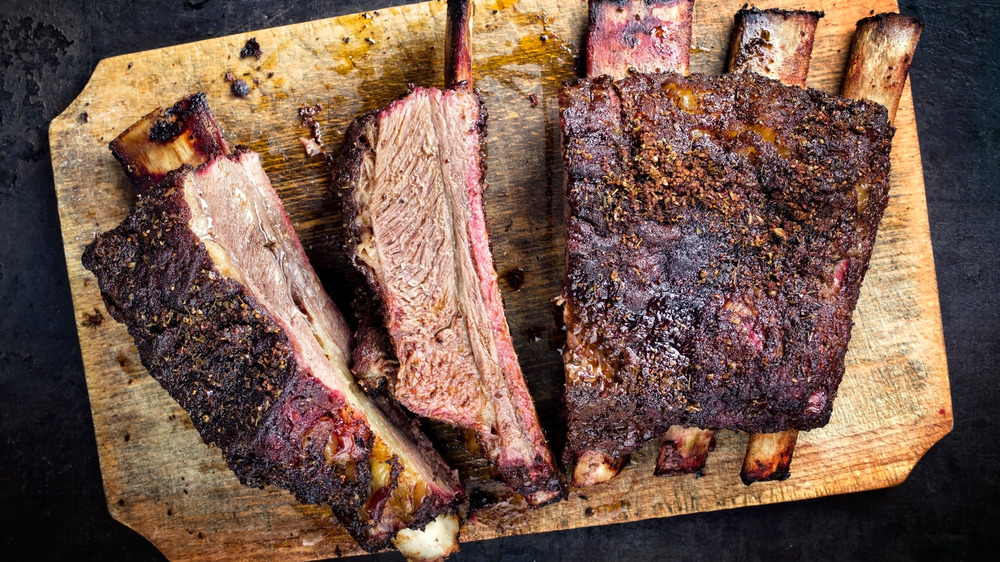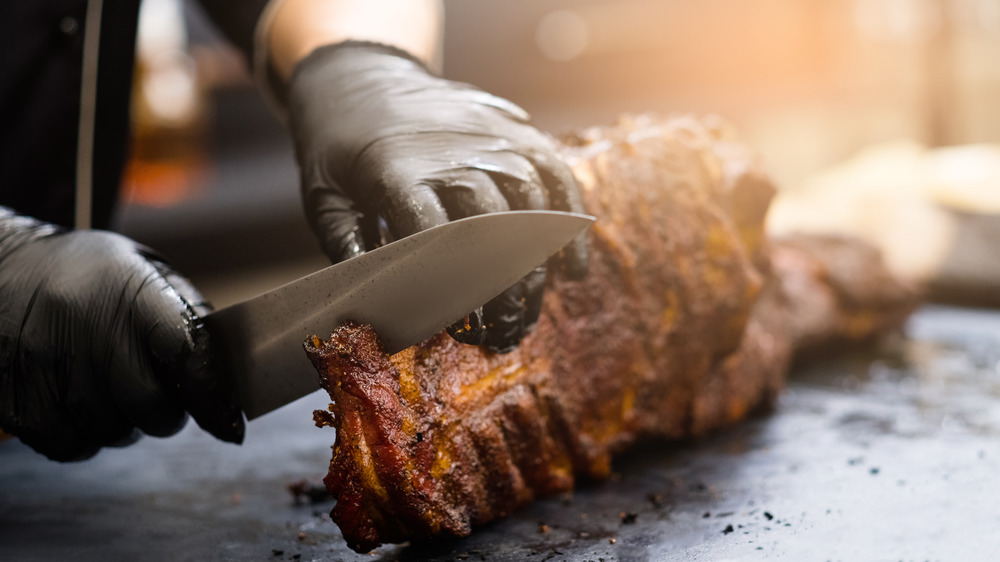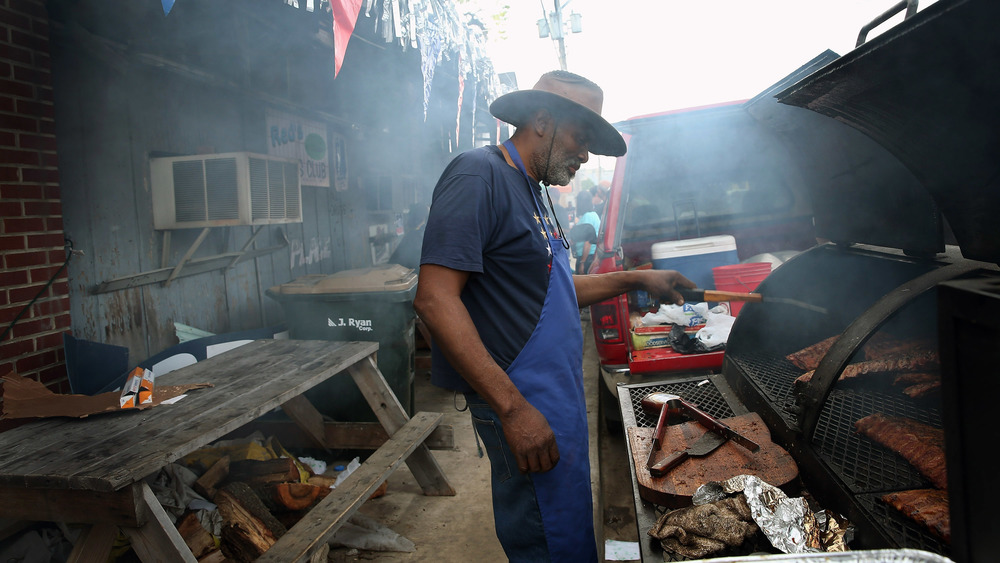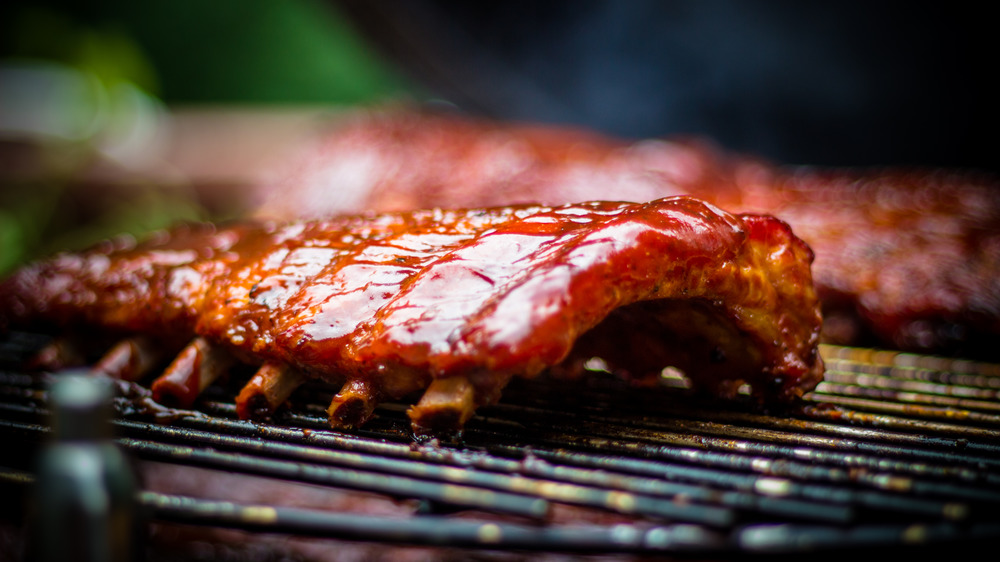Grillmaster Reveals Mistakes You're Making While Smoking Ribs On The Grill
The practice of roasting meat over an open fire dates back millennia. However, the modern concept of barbecuing comes from the Taino, an indigenous tribe in the Caribbean, according to Live Science. Their practice of cooking meat over a fire, called barbacoa, caught the eye of Spanish explorers, who brought the practice back to Europe around the 16th century. From that point forward, barbecue became intertwined with the history of America and has become a fixture at celebrations and summer cookouts ever since.
If you love participating in this outdoor cooking tradition, you also have come to terms with the difficulties any grillmaster faces. Making the perfect ribs on a grill offers a particular challenge, but luckily, Michael Ollier, senior corporate chef for the Certified Angus Beef brand and a certified Kansas City Barbeque Society judge, has some answers as to how we can improve our rib game. As a judge for events like The Jack Daniel's World Championship Invitational Barbecue and the American Royal, nobody knows their way around a smoker like Ollier.
When it comes to rib cuts, do your homework
One huge mistake people make is treating all rib cuts alike. Getting familiar with your meat can make the entire cooking process that much faster and better. "Beef Plate short ribs, chuck short ribs, and back ribs are all very different cuts, each with unique characteristics and ideal cooking techniques," Ollier explained to Mashed. "Do your homework before you go to the store and have a conversation with your butcher to help choose the right cut."
By paying attention to the marbling of each particular cut, you can ensure to use the right cooking method for each kind of rib. "Knowing fat is important," Ollier said. "There can be large areas of fat on ribs. [This is] especially true on plate short ribs — think of what raw bacon looks like." Additionally, you want to look for a cut with a clear mix of fat and lean meat. "Balance is key," Ollier stressed. "Seek out abundant marbling or little flecks within the lean for high quality."
When in doubt, make sure you also buy quality beef. "Look for the Certified Angus Beef brand to get quality beef every time," Ollier recommends. "If you're trying beef ribs for the first time, start with chuck short ribs because they have a more even distribution of marbling in the lean meat."
When you really should be rubbing down your ribs
Nothing makes a rack of ribs stand out like a signature spice rub, but don't wait too long to start. "Rub down ribs with your fave concoction the day ahead to allow for salt penetration and to impart flavor," Ollier said. "Also, use the right amount. Two pounds of beef back ribs should get less volume than a 4-pound block of plate short ribs. Letting the rub sit overnight allows the salt to penetrate deep into the cut, imparting more flavor on the whole bite of beef."
If you have just started your rib journey, nothing beats a classic sugar and spice rub. According to Hey Grill Hey, a combo of brown sugar, salt, pepper, cayenne, paprika, garlic powder, cinnamon, onion powder, and celery salt can do wonders to your next rack.
Don't even think about dunking these perfectly-rubbed ribs into boiling water, either. "Low and slow and smoked over indirect heat is the gold standard cooking technique for most all ribs," Ollier said. "Boiled?! Just no. Braised with barbecue sauce in crock-pot? Hand slap. By boiling, you have no seasoning penetration, no smoke, no bark — you miss out on everything savory about ribs. If you boil, then bake ribs, that's equivalent to cooking a steak in a microwave. Just ... no."
If it's falling off the bone, it's probably overcooked
When you imagine your perfect rib, you might picture a juicy cut of meat that falls right off the bone. According to Ollier, this misconception has affected the way we typically approach barbecue. "Competition barbecue folks know that 'fall-off-the-bone tender' sounds great to most but translates to overcooked ribs and no blue ribbon," Ollier said. "Properly cooked ribs should still be tender, but have some friendly tug, with a little meat left off the bone."
According to Ollier, you're looking for both bark and bite in your finished ribs. That means a perfect exterior on your ribs. "A good rub and proper smoking makes for a great crusty bark," Ollier explained. "Wrapping ribs midway through the cook (foil or peach paper) will protect moisture for a tender bite. I'm disappointed when ribs don't have a crust to contrast the tender bite of beef."
If you find your ribs drying out, Ollier also has a solution. "Add a bit of extra moisture, like broth or juice, to the wrap to keep it extra tender," Ollier recommended.
One thing to remember: it all starts with the meat. If you mess up your cooking process, your sauce can't save you. "You can't cover the flavor of mediocre ribs with awesome sauce," Ollier said. "Start with quality and let that beef flavor shine! Rubs and sauces are meant to enhance, not overpower."



